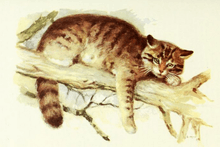Caucasian wildcat
The Caucasian wildcat (Felis silvestris caucasica) is a European wildcat subspecies that inhabits the Caucasus Mountains and Turkey.[1]
| Caucasian wildcat | |
|---|---|
 | |
| Scientific classification | |
| Kingdom: | Animalia |
| Phylum: | Chordata |
| Class: | Mammalia |
| Order: | Carnivora |
| Suborder: | Feliformia |
| Family: | Felidae |
| Subfamily: | Felinae |
| Genus: | Felis |
| Species: | |
| Subspecies: | F. s. caucasica |
| Trinomial name | |
| Felis silvestris caucasica Satunin, 1905 | |
| Synonyms | |
| |
Taxonomy
Felis silvestris caucasica was described by Konstantin Satunin in 1905 on the basis of a skin of a female cat collected near Borjomi in Georgia.[2]
Felis silvestris trapezia was proposed in 1916 for a male zoological specimen in the collection of the Natural History Museum, London, which originated in the vicinity of Trabzon in northern Turkey.[3]
Characteristics
The Caucasian wildcat differs from the European wildcat by being lighter gray in colour, with a fainter pattern on the sides and the tail. It is similar in size, measuring 70–75 cm (28–30 in) in head to body length, 26–28 cm (10–11 in) in shoulder height. It weighs 5.2–6 kg (11–13 lb), rarely more than 8 kg (18 lb).[4]
Distribution and habitat
In Turkey, the wildcat is considered common in mesic and mixed oak-beech forests of the Pontic Mountains, but rare in the Marmara and Aegean Sea regions. In the Taurus Mountains, it probably only occurs in deciduous forest of Kahramanmaraş Province. It is possibly extinct in the Eastern Anatolia Region.[5]
References
- Kitchener, A. C.; Breitenmoser-Würsten, C.; Eizirik, E.; Gentry, A.; Werdelin, L.; Wilting, A.; Yamaguchi, N.; Abramov, A. V.; Christiansen, P.; Driscoll, C.; Duckworth, J. W.; Johnson, W.; Luo, S.-J.; Meijaard, E.; O’Donoghue, P.; Sanderson, J.; Seymour, K.; Bruford, M.; Groves, C.; Hoffmann, M.; Nowell, K.; Timmons, Z.; Tobe, S. (2017). "A revised taxonomy of the Felidae: The final report of the Cat Classification Task Force of the IUCN Cat Specialist Group" (PDF). Cat News (Special Issue 11): 16–17.
- Satunin, K. A. (1905). "Die Säugetiere des Talyschgebietes und der Mughansteppe" [The Mammals of the Talysh area and the Mughan steppe]. Mitteilungen des Kaukasischen Museums (2): 87–402.
- Blackler, W. G. F. (1916). "On two new carnivores from Asia Minor". Annals and Magazine of Natural History. Series 8. 18 (103): 73–77. doi:10.1080/00222931608693825.
- Heptner, V. G.; Sludskii, A. A. (1992) [1972]. "Wildcat". Mlekopitajuščie Sovetskogo Soiuza. Moskva: Vysšaia Škola [Mammals of the Soviet Union, Volume II, Part 2. Carnivora (Hyaenas and Cats)]. Washington DC: Smithsonian Institution and the National Science Foundation. pp. 398–498.
- Can, O. E.; Kandemïr, I.; Togan, I. (2011). "The wildcat Felis silvestris in northern Turkey: assessment of status using camera trapping". Oryx. 45 (1): 112–118. doi:10.1017/S0030605310001328.